By Jeffrey A. Rendall; Photos By Jeff Janas
FREDERICKSBURG, VA – “I designed Cannon Ridge to be what I call a real ‘throwback’ golf course,” replied Deane Beman, former PGA Tour Commissioner and sometime golf course designer, when asked what his thoughts were for the new golf facility along the banks of the Rappahanock River, near Fredericksburg in Virginia.
‘Throwback’ has its own set of meanings, and you personally might recall hearing the term while fishing as a youngster, dreading the sound of the word as Dad said to toss that six-inch trout you’d labored so hard to land back in the lake.
But there’s none of that type of ‘throwback’ at Cannon Ridge, as it’s an excellent tribute to golf from a bygone, more traditional golf era – where tricks weren’t treats, and the land told you where to put things, at least in the golf sense.
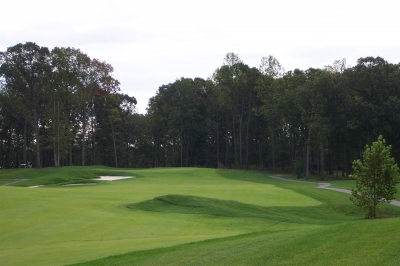 |
| At 410 yards, the 1st hole lulls you to sleep. But if you miss right, as most players do, you probably won't be marking down a par to start your round. |
Beman explains: “It’s reminiscent of how the classic architects designed golf courses back in the golden age, back in the 1920’s. We used existing terrain, didn’t move a lot of dirt – and then, because we had quite a bit of land to work with, positioned tees and features around some very difficult topographical areas. We’re right there on the bluff overlooking the Rappahanock River, so it was a bit of a challenge to make everything work.”
It certainly did work. The Beman Course (with Bobby Weed consulting) is the first of three potential golf layouts at Cannon Ridge (the 2nd course, designed by Weed, is in the initial construction stages), which is part of the ‘Celebrate Virginia’ development, dreamed up by Larry Silver of Fredericksburg Central Park fame.
Bob Baldassari, Cannon Ridge’s General Manager/Head Golf Professional talks about the ‘history’ involved with the project: “I believe Mr. Silver formulated the idea for Celebrate Virginia many years ago, where he envisioned a multi-dimensional site with businesses like you’d find at Central Park, but also a tourism component, a golf component and even an area where corporations could have their business headquarters. The Washington area’s been growing in this direction for quite a while, so it makes sense to put this type of development here.”
He continues, “Cannon Ridge is technically separate from Celebrate Virginia – it’s the golf component within Celebrate Virginia’s confines. It’s a matter of educating people that the big picture is Celebrate Virginia, and our facility is the golf component of the big picture – part of the 3000 acres that will be Celebrate Virginia. There’s also going to be an equestrian center here, and the National Slavery Museum will be located at this site.”
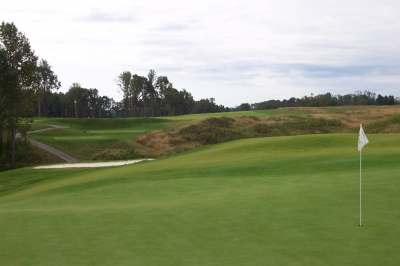 |
| Only 179 yards and fairly wide open, the 17th hole is rated second easiest on the back nine. But if you're in one of the bunkers surrounding the green, par's a very good score, indeed. |
It’s a good place to put historically themed attractions, since the land itself is coined ‘Cannon Ridge’ for more than just a cool sounding name. Baldassari said the land figured prominently in the Fredericksburg Civil War campaigns of 1862-63, and there are interpretive signs placed at different points of the golf course denoting such occurrences, including Union General Ambrose Burnside’s infamous ‘Mud March’ that took place in January of 1863.
The Yankees may have bogged down on this land, but golf’s taken over in the 21st century – in a good way. As this history buff would attest, there’s nothing tasteless about putting a golf facility here, and measures were taken to treat the land with the deference it deserves.
Beman wouldn’t have it any other way: “We were very, very sensitive to the historical impact of the golf course. We had to follow very strict guidelines in building the layout, and if it dictated that we move some things, we did. There are a couple holes out there that would be different if we didn’t have to comply with the regulations, but we respected them and that’s the way it should be.”
Cannon Ridge’s patrons benefit from Beman’s careful use of the land. And as noted above, it was a difficult task to place the golf holes where you can play the course without encountering too many of the land’s undulating natural hazards.
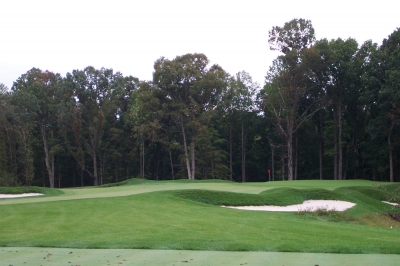 |
| At 166 yards, the par three 7th hole is the shortest on the course. Pay close attention to the pin placement, however, as even the slightest miss could land you in trouble. |
“There’s a lot of relief on that property,” Beman commented. “The hills and the ravines that you’ve got to play over and around. We were able to position tees for every level of golfer so you won’t have forced carries if you pick the right tee to play from. If you’re a really bad player and play from the back tees, you’re going to have a lot of problems out there.”
That’s highly discouraged. We looked at the course from the tips, and if you can’t fly the ball at least 200-210 yards on a regular basis, don’t even think about that first stop on the cart path. But the course isn’t designed for lighter hitting players to challenge the yardage, either.
“We built Cannon Ridge to be a four hour golf course, and the way we did that was incorporating various levels of tees for different kinds of play, as everybody tries to do. We gave a pretty generous area for hitting your tee shot, and the greens are small – and they’re pitched from back to front, like they used to build before they had internal drainage,” Beman added.
“Another way we made it player friendly was by opening the front of the greens – there are only a few holes where you have any kind of forced carry at the beginning of the putting surface, because the front and approaches to the green are almost part of the green itself. And it’s all the same kind of bentgrass – they just mow it a little higher in the front,” Beman said.
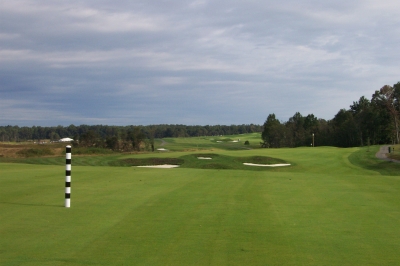 |
| The 575 yard, par five 16th hole is wide open. If you can't place a tee ball here, you better spend some more time on the range. But, the second and potential third shots will challenge you. |
Bentgrass being somewhat unique this far south. More and more courses are going to bentgrass, even in the hotter climates of the Mid-Atlantic. Cannon Ridge certainly wasn’t the first, but it would’ve probably been easier to give in and plant Bermuda grass. Nothing against that type of grass, but when it’s dormant for half the year, it’s much easier to play off the greener stuff (not to mention a lot nicer to look at).
After seeing Cannon Ridge, you’d probably be surprised to learn it’s Beman’s first signature golf design. Newness usually means inexperience and mistakes – which in a golf course setting might translate to design elements that don’t seem to fit, or as we’re fond of saying, ‘goofiness.’
Baldassari dispels the notion: “Our Beman Course was Deane’s first signature design, true, but he’s largely credited with popularizing the TPC (Tournament Player’s Club) concept, so he’s been around golf design virtually his entire career. He’s worked with many different architects over the years, and of course, because of his playing career, he’s seen courses all over the world. In other words, he’s got a pretty good idea of what he wants, and this course has his design thoughts all throughout.”
For his part, Beman is the first one to credit Bobby Weed with helping him put his ideas into tangible reality: “Bobby helped me with the routing and was out there doing all the technical things. I had a concept that I wanted to build, but Bobby helped make that concept into a playable golf course, with proper drainage and construction.”
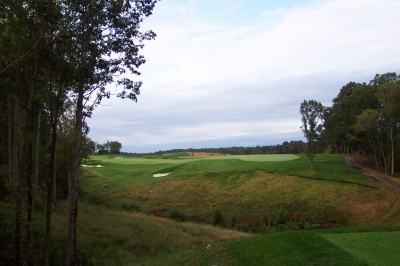 |
| Now that's intimidation -- the short par four 8th (389 yards) definitely fits in the strategic category -- but tell that to your driver when hitting from the tee. |
Beman’s ‘throwback’ concepts include ensuring a walker-friendly design, even with the difficult terrain. Then there’s pace of play. Most courses stress it (or should I say, stress over it), but at Cannon Ridge, it’s been part of the plan, from the beginning.
“Our tees and greens were specifically designed to help speed up play,” Baldassari expounded. “Pace of play is one of our biggest campaigns, since we believe it’s one of the most important factors in making sure people enjoy the golf experience.”
There’s more: “We’re off the path with the carts, and we currently have 10 minute intervals between tee times. The landing areas are pretty generous in most spots, and we don’t leave the rough very high. Deane wants to keep it at minimal height, so you can find your ball quickly and play it. We’re doing everything we can for pace of play, because our players expect it” Baldassari added.
As a final note before describing a few of the highlight holes is the conditioning. Cannon Ridge opened for play last July (2003), and quickly acquired a not-so-desirable reputation for conditioning. The wet summer delayed grow-in more than usual, and the playing conditions weren’t the greatest (from some anonymous sources) to start off with.
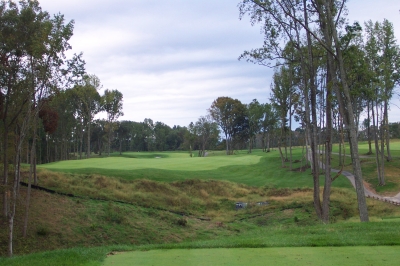 |
| The 12th hole characterizes all that is Virginia Golf. Hardwoods, undulations, stunning beauty. Almost makes you want to set up camp here. |
That too, like so much at Cannon Ridge, is a thing of the past. Baldassari explains: “Deane Beman wants a TPC-quality golf experience at Cannon Ridge, which includes turfgrass conditions. They debated long and hard before deciding on bentgrass – and there’s a talent, a science to keeping it healthy and thriving in the hot months. As a result, we brought in Chad Adcock, who was familiar with growing the grass in a hot climate at Kinloch (Golf Club in Richmond).”
If Adcock can keep Cannon Ridge looking anything like Kinloch, it’ll be a special place, indeed.
Highlight holes include number three, a 586 yard par five. From the back sets, you’re firing over a large ravine from the tee, but the landing area is very large. From there, you’ve got a bit of a decision, as you’re looking at another sizeable carry over natural areas to reach the green. There is plenty of room to lay up to the left, should you choose the safer play.
Four, five and six are the ‘meat’ of the front nine, a 228 yard par three, 461 yard par four and a 493 yard par four. Five is the number one handicap hole, 461 yards working uphill to beautifully framed green on the hill. Beman said they’d originally intended to lower the green a bit to make the hole play a little easier, but history intervened (an archeological situation), and they couldn’t remove the dirt.
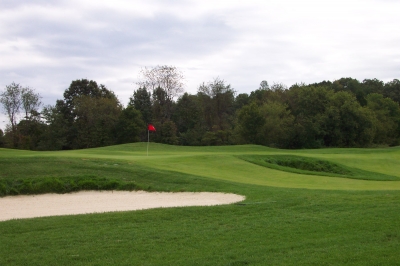 |
| Greenside at the par four 2nd hole. Like many holes at Cannon Ridge, if you surive the tee shot, getting to this point shouldn't be that difficult. |
Turning to the back, the twelfth hole is one of the most picturesque par fives you’ll see anywhere. It’s Virginia Golf at its finest. Beman’s again given you a wide area to drive the ball, but if you’re too long down the left side, the ball will roll down an embankment into the rough. That’ll leave a tough lay up, too. If you’re in the fairway on the right, you might be able to try for the green in two, though the green’s raised up – one of those few forced carries Beman was talking about earlier.
Thirteen’s another interesting par four (431 yards), primarily on the second shot – it almost looks like there are two greens to shoot at. Baldassari explains: “When they first laid out that hole, they had a restriction on how far back into the trees they could go. So, there’s a bunker over to the left side that almost looks like it’s near a green – but they left it, because when you drive it into the fairway bunker and you’re hitting into the green, that bunker may come into play.”
It fits the ‘throwback’ style, in a sense. Some things might appear not to be in play when in actuality, they are, just like the courses in the Old Country.
The Beman Course at Cannon Ridge is quite a great start to the golf component at Celebrate Virginia, and we’ll certainly look forward to seeing the Weed Course open in the coming seasons at the same location.
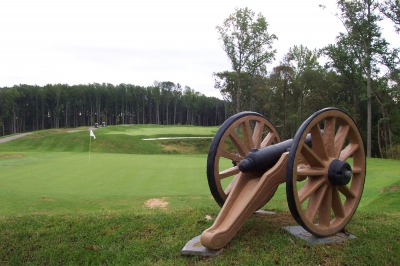 |
| If the spirits fail to remind you where you are, the relics and signs won't. Here, alongside the 14th green. |
It’s so enjoyable, you’ll definitely label it a ‘keeper.’ Take that one, Dad.
Note: Check links below for more stories on golf in the Fredericksburg area.
Details:
Cannon Ridge Golf Club
Phone: (540) 735-8000; (866) 85-RIDGE
FAX: (540) 735-8029
Website: www.cannonridge.com
Course Designer: Deane Beman (Bobby Weed Consulting)
General Manager/Head Golf Professional: Bob Baldassari, PGA
Course Superintendent:
Assistant Golf Professional: Jeff May
Tees/Yardage/Slope/Rating
Cannon 7010/147 75.8
Blue 6610/140 73.0
Gray 6050/136, 144 (L) 70.2, 74.3 (L)
Battle 5625/120, 135 (L) 69.3, 71.6 (L)
Ridge 4655 67.3
Rates: (Off Season, through March 15, 2004)
M-Th: $35, 9 holes: $15
Fri: $40, 9 holes: $20
Weekends/Holidays: $45, 9 holes: $25
Regular Season rates for last season (2003);
M-Th: $55 morning, $45 mid-morning, $39 after 1.
Fri: $60 morning, $50 mid-morning, $39 after 1.
Weekends/Holidays: $65 morning, $55 mid-morning, $45 after 1.
There’s also an afternoon 9-hole rate, and a Junior (walking) rate.
All prices include cart, greens fee, tax and range balls. There’s a large practice facility at Cannon Ridge, and several instructional programs are available.
| Related Links | Comments on this article? | |
|
Maryland National Golf Club Hollow Creek Golf Club Rocky Gap Resort PB Dye Golf Club in Ijamsville Whiskey Creek Golf Club |
E-mail Jeff Rendall, Editor: jrendall@golftheunitedstates.com |












